Abstract
Transcription of the genes for the human histone proteins H4, H3, H2A, H2B, and H1 is activated at the G1/S phase transition of the cell cycle. We have previously shown that the promoter complex HiNF-D, which interacts with cell cycle control elements in multiple histone genes, contains the key cell cycle factors cyclin A, CDC2, and a retinoblastoma (pRB) protein-related protein. However, an intrinsic DNA-binding subunit for HiNF-D was not identified. Many genes that are up-regulated at the G1/S phase boundary are controlled by E2F, a transcription factor that associates with cyclin-, cyclin-dependent kinase-, and pRB-related proteins. Using gel-shift immunoassays, DNase I protection, and oligonucleotide competition analyses, we show that the homeodomain protein CDP/cut, not E2F, is the DNA-binding subunit of the HiNF-D complex. The HiNF-D (CDP/cut) complex with the H4 promoter is immunoreactive with antibodies against CDP/cut and pRB but not p107, whereas the CDP/cut complex with a nonhistone promoter (gp91-phox) reacts only with CDP and p107 antibodies. Thus, CDP/cut complexes at different gene promoters can associate with distinct pRB-related proteins. Transient coexpression assays show that CDP/cut modulates H4 promoter activity via the HiNF-D-binding site. Hence, DNA replication-dependent histone H4 genes are regulated by an E2F-independent mechanism involving a complex of CDP/cut with cyclin A/CDC2/ RB-related proteins.
Full text
PDF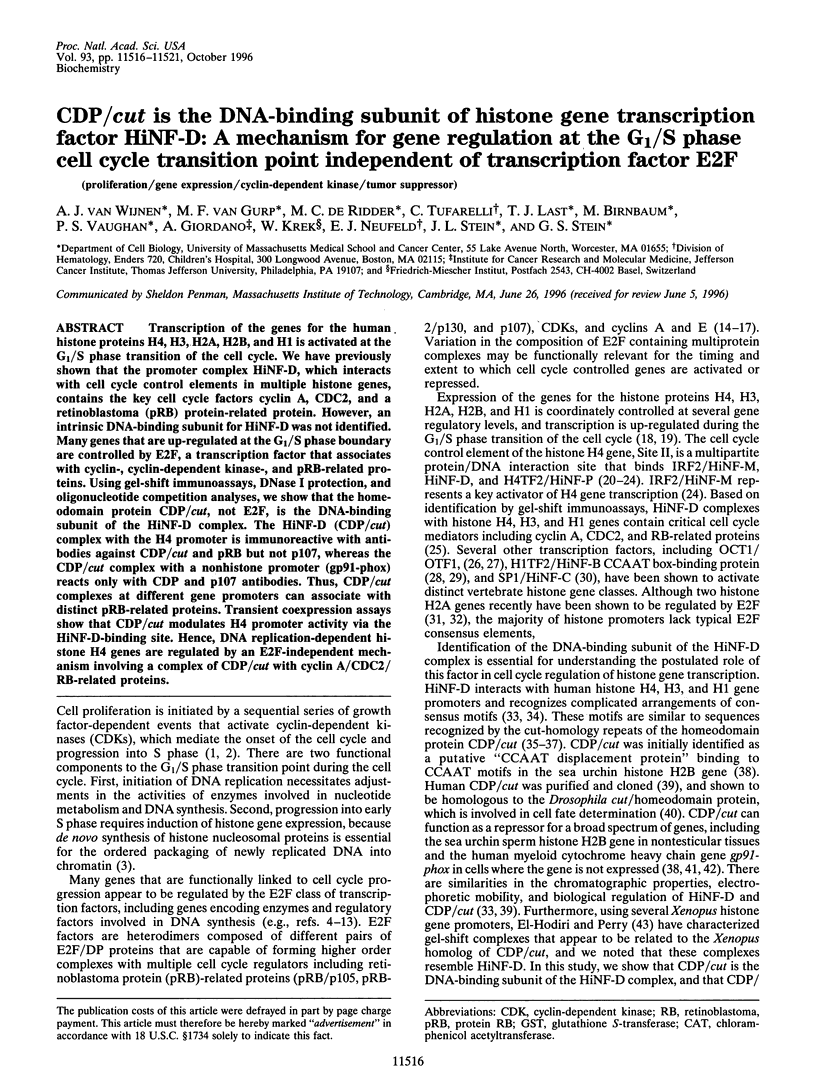
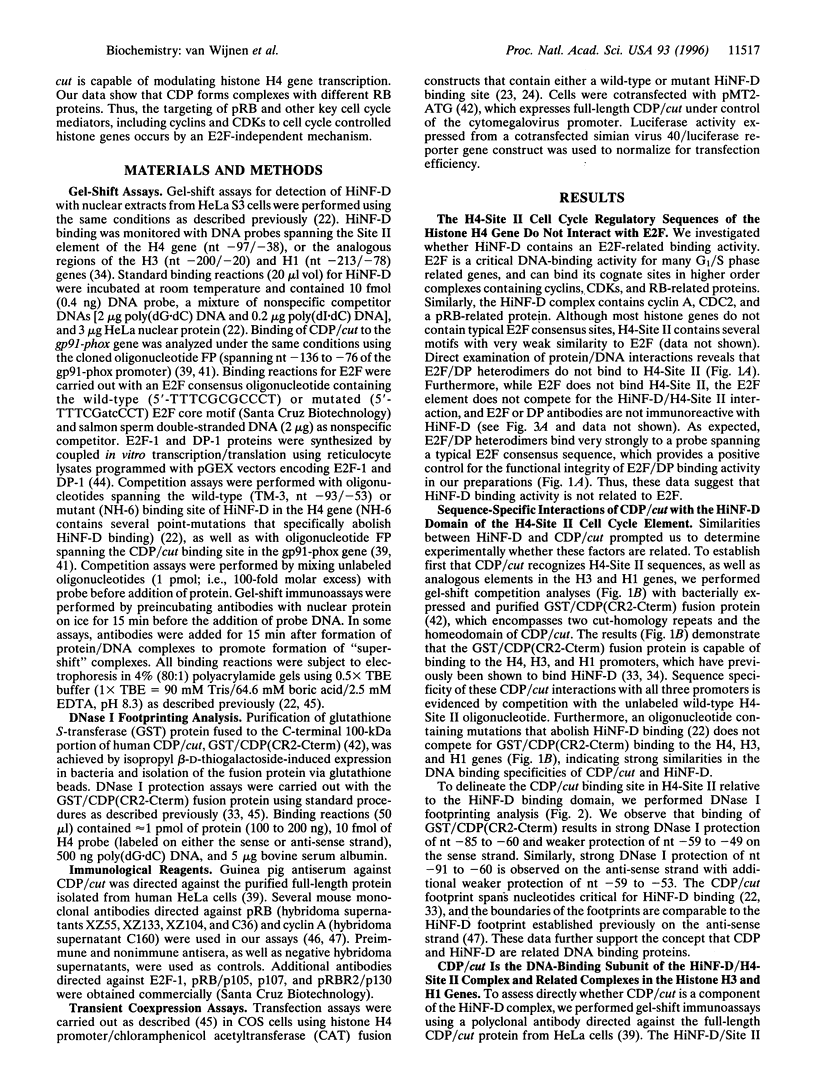
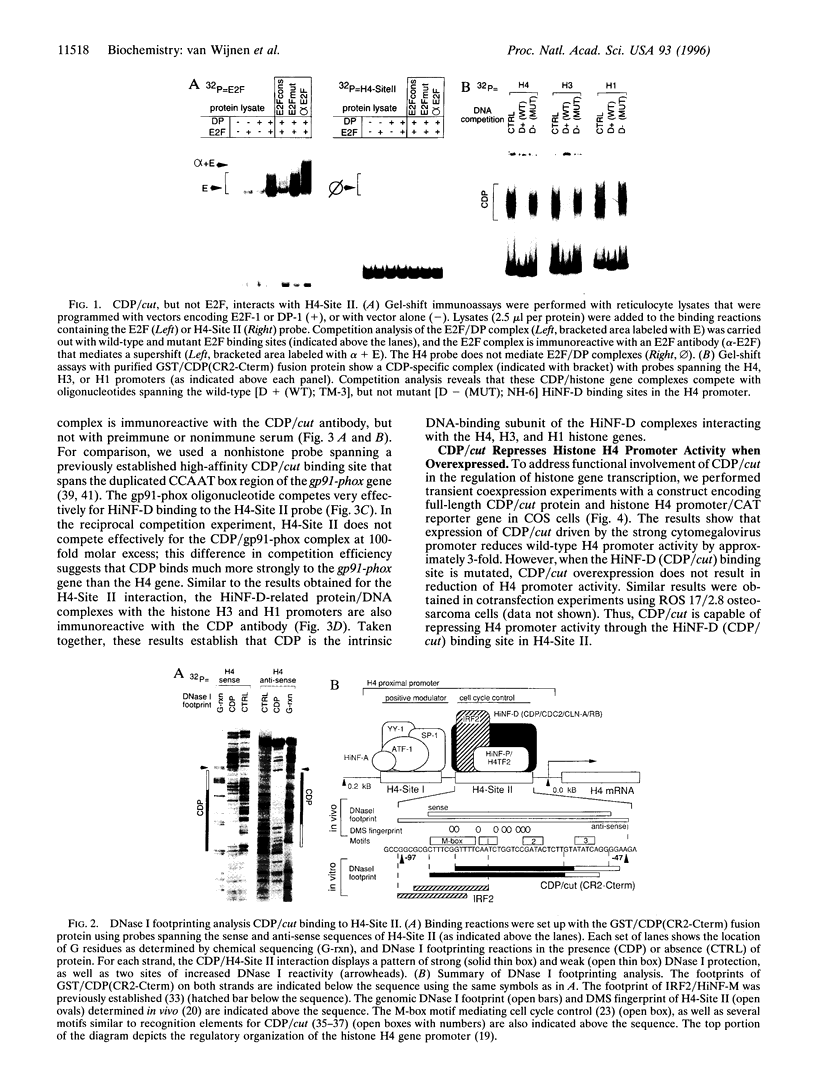
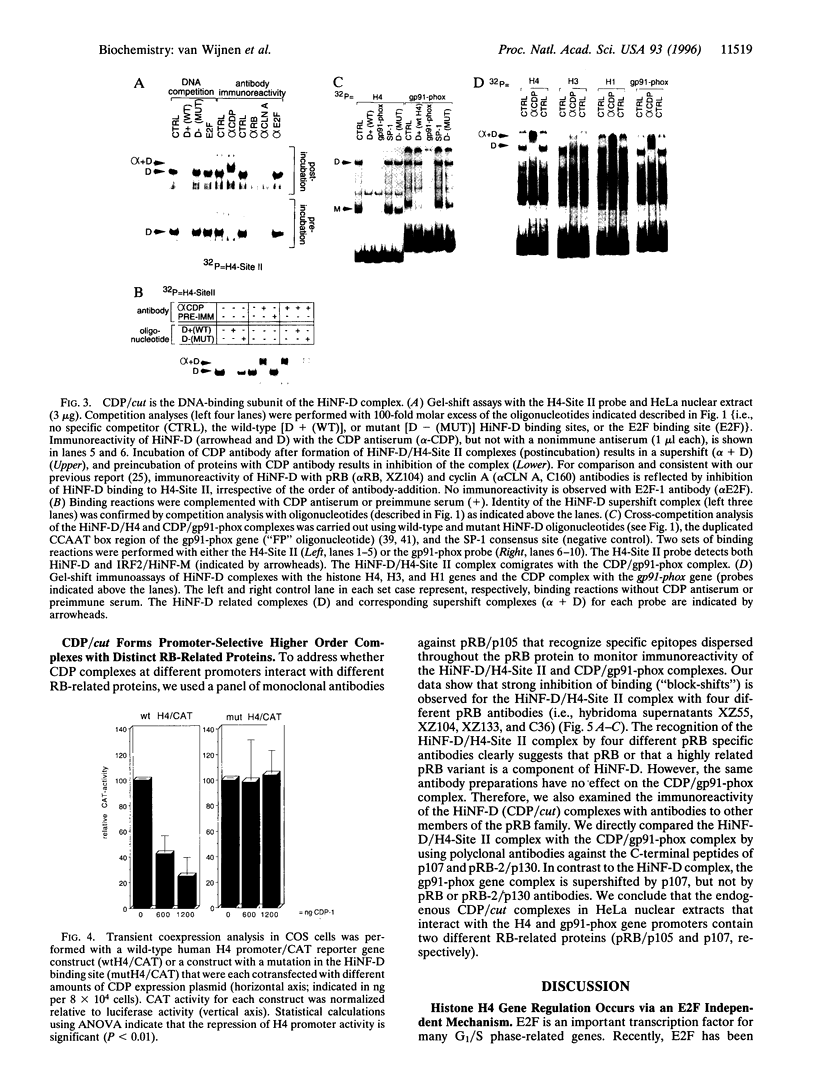
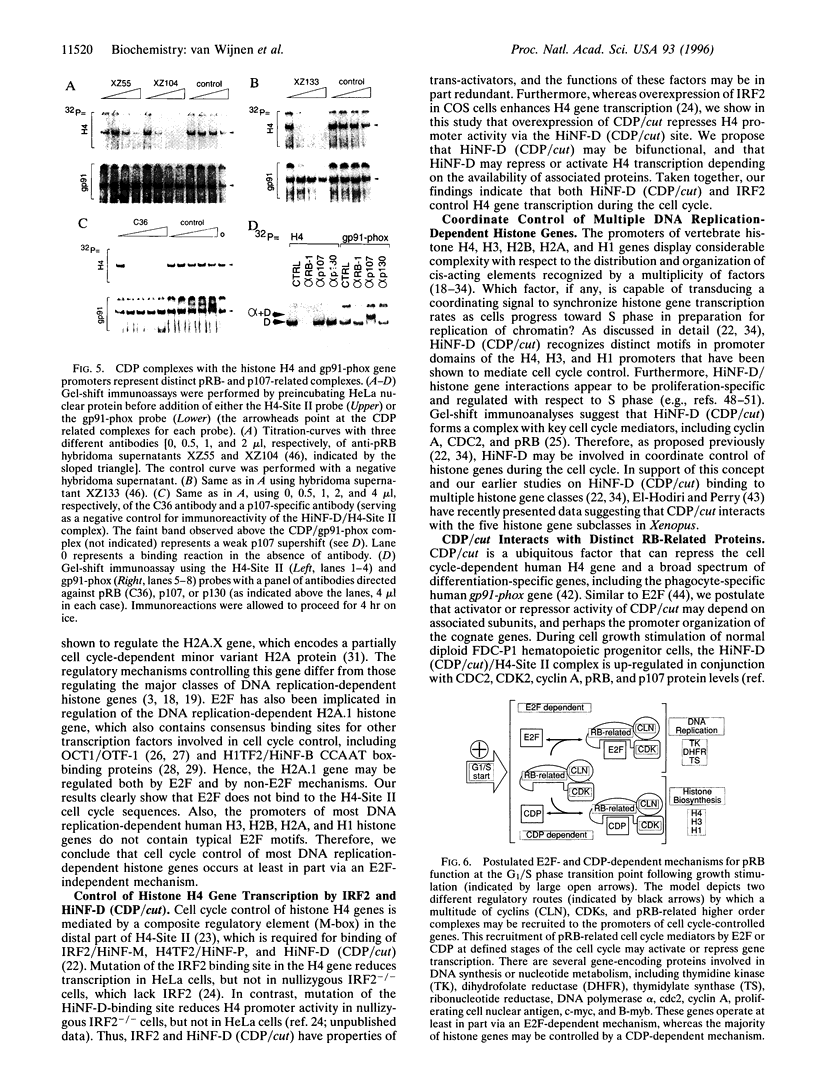
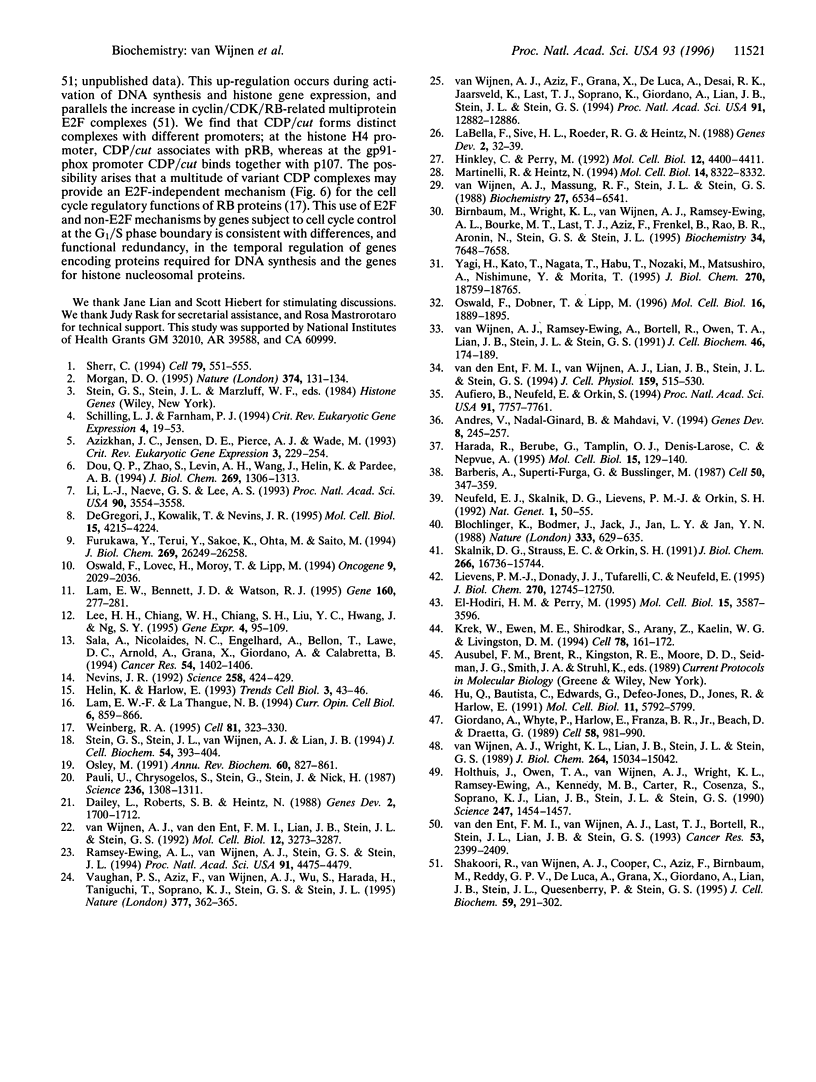
Images in this article
Selected References
These references are in PubMed. This may not be the complete list of references from this article.
- Andrés V., Chiara M. D., Mahdavi V. A new bipartite DNA-binding domain: cooperative interaction between the cut repeat and homeo domain of the cut homeo proteins. Genes Dev. 1994 Jan;8(2):245–257. doi: 10.1101/gad.8.2.245. [DOI] [PubMed] [Google Scholar]
- Aufiero B., Neufeld E. J., Orkin S. H. Sequence-specific DNA binding of individual cut repeats of the human CCAAT displacement/cut homeodomain protein. Proc Natl Acad Sci U S A. 1994 Aug 2;91(16):7757–7761. doi: 10.1073/pnas.91.16.7757. [DOI] [PMC free article] [PubMed] [Google Scholar]
- Azizkhan J. C., Jensen D. E., Pierce A. J., Wade M. Transcription from TATA-less promoters: dihydrofolate reductase as a model. Crit Rev Eukaryot Gene Expr. 1993;3(4):229–254. [PubMed] [Google Scholar]
- Barberis A., Superti-Furga G., Busslinger M. Mutually exclusive interaction of the CCAAT-binding factor and of a displacement protein with overlapping sequences of a histone gene promoter. Cell. 1987 Jul 31;50(3):347–359. doi: 10.1016/0092-8674(87)90489-2. [DOI] [PubMed] [Google Scholar]
- Birnbaum M. J., Wright K. L., van Wijnen A. J., Ramsey-Ewing A. L., Bourke M. T., Last T. J., Aziz F., Frenkel B., Rao B. R., Aronin N. Functional role for Sp1 in the transcriptional amplification of a cell cycle regulated histone H4 gene. Biochemistry. 1995 Jun 13;34(23):7648–7658. doi: 10.1021/bi00023a011. [DOI] [PubMed] [Google Scholar]
- Dailey L., Roberts S. B., Heintz N. Purification of the human histone H4 gene-specific transcription factors H4TF-1 and H4TF-2. Genes Dev. 1988 Dec;2(12B):1700–1712. doi: 10.1101/gad.2.12b.1700. [DOI] [PubMed] [Google Scholar]
- DeGregori J., Kowalik T., Nevins J. R. Cellular targets for activation by the E2F1 transcription factor include DNA synthesis- and G1/S-regulatory genes. Mol Cell Biol. 1995 Aug;15(8):4215–4224. doi: 10.1128/mcb.15.8.4215. [DOI] [PMC free article] [PubMed] [Google Scholar]
- Dou Q. P., Zhao S., Levin A. H., Wang J., Helin K., Pardee A. B. G1/S-regulated E2F-containing protein complexes bind to the mouse thymidine kinase gene promoter. J Biol Chem. 1994 Jan 14;269(2):1306–1313. [PubMed] [Google Scholar]
- Furukawa Y., Terui Y., Sakoe K., Ohta M., Saito M. The role of cellular transcription factor E2F in the regulation of cdc2 mRNA expression and cell cycle control of human hematopoietic cells. J Biol Chem. 1994 Oct 21;269(42):26249–26258. [PubMed] [Google Scholar]
- Giordano A., Whyte P., Harlow E., Franza B. R., Jr, Beach D., Draetta G. A 60 kd cdc2-associated polypeptide complexes with the E1A proteins in adenovirus-infected cells. Cell. 1989 Sep 8;58(5):981–990. doi: 10.1016/0092-8674(89)90949-5. [DOI] [PubMed] [Google Scholar]
- Harada R., Bérubé G., Tamplin O. J., Denis-Larose C., Nepveu A. DNA-binding specificity of the cut repeats from the human cut-like protein. Mol Cell Biol. 1995 Jan;15(1):129–140. doi: 10.1128/mcb.15.1.129. [DOI] [PMC free article] [PubMed] [Google Scholar]
- Helin K., Ed H. The retinoblastoma protein as a transcriptional repressor. Trends Cell Biol. 1993 Feb;3(2):43–46. doi: 10.1016/0962-8924(93)90150-y. [DOI] [PubMed] [Google Scholar]
- Hinkley C., Perry M. Histone H2B gene transcription during Xenopus early development requires functional cooperation between proteins bound to the CCAAT and octamer motifs. Mol Cell Biol. 1992 Oct;12(10):4400–4411. doi: 10.1128/mcb.12.10.4400. [DOI] [PMC free article] [PubMed] [Google Scholar]
- Holthuis J., Owen T. A., van Wijnen A. J., Wright K. L., Ramsey-Ewing A., Kennedy M. B., Carter R., Cosenza S. C., Soprano K. J., Lian J. B. Tumor cells exhibit deregulation of the cell cycle histone gene promoter factor HiNF-D. Science. 1990 Mar 23;247(4949 Pt 1):1454–1457. doi: 10.1126/science.247.4949.1454. [DOI] [PubMed] [Google Scholar]
- Hu Q. J., Bautista C., Edwards G. M., Defeo-Jones D., Jones R. E., Harlow E. Antibodies specific for the human retinoblastoma protein identify a family of related polypeptides. Mol Cell Biol. 1991 Nov;11(11):5792–5799. doi: 10.1128/mcb.11.11.5792. [DOI] [PMC free article] [PubMed] [Google Scholar]
- Krek W., Ewen M. E., Shirodkar S., Arany Z., Kaelin W. G., Jr, Livingston D. M. Negative regulation of the growth-promoting transcription factor E2F-1 by a stably bound cyclin A-dependent protein kinase. Cell. 1994 Jul 15;78(1):161–172. doi: 10.1016/0092-8674(94)90582-7. [DOI] [PubMed] [Google Scholar]
- LaBella F., Sive H. L., Roeder R. G., Heintz N. Cell-cycle regulation of a human histone H2b gene is mediated by the H2b subtype-specific consensus element. Genes Dev. 1988 Jan;2(1):32–39. doi: 10.1101/gad.2.1.32. [DOI] [PubMed] [Google Scholar]
- Lam E. W., Bennett J. D., Watson R. J. Cell-cycle regulation of human B-myb transcription. Gene. 1995 Jul 28;160(2):277–281. doi: 10.1016/0378-1119(95)00184-8. [DOI] [PubMed] [Google Scholar]
- Lam E. W., La Thangue N. B. DP and E2F proteins: coordinating transcription with cell cycle progression. Curr Opin Cell Biol. 1994 Dec;6(6):859–866. doi: 10.1016/0955-0674(94)90057-4. [DOI] [PubMed] [Google Scholar]
- Lee H. H., Chiang W. H., Chiang S. H., Liu Y. C., Hwang J., Ng S. Y. Regulation of cyclin D1, DNA topoisomerase I, and proliferating cell nuclear antigen promoters during the cell cycle. Gene Expr. 1995;4(3):95–109. [PMC free article] [PubMed] [Google Scholar]
- Li L. J., Naeve G. S., Lee A. S. Temporal regulation of cyclin A-p107 and p33cdk2 complexes binding to a human thymidine kinase promoter element important for G1-S phase transcriptional regulation. Proc Natl Acad Sci U S A. 1993 Apr 15;90(8):3554–3558. doi: 10.1073/pnas.90.8.3554. [DOI] [PMC free article] [PubMed] [Google Scholar]
- Lievens P. M., Donady J. J., Tufarelli C., Neufeld E. J. Repressor activity of CCAAT displacement protein in HL-60 myeloid leukemia cells. J Biol Chem. 1995 May 26;270(21):12745–12750. doi: 10.1074/jbc.270.21.12745. [DOI] [PubMed] [Google Scholar]
- Martinelli R., Heintz N. H1TF2A, the large subunit of a heterodimeric, glutamine-rich CCAAT-binding transcription factor involved in histone H1 cell cycle regulation. Mol Cell Biol. 1994 Dec;14(12):8322–8332. doi: 10.1128/mcb.14.12.8322. [DOI] [PMC free article] [PubMed] [Google Scholar]
- Morgan D. O. Principles of CDK regulation. Nature. 1995 Mar 9;374(6518):131–134. doi: 10.1038/374131a0. [DOI] [PubMed] [Google Scholar]
- Neufeld E. J., Skalnik D. G., Lievens P. M., Orkin S. H. Human CCAAT displacement protein is homologous to the Drosophila homeoprotein, cut. Nat Genet. 1992 Apr;1(1):50–55. doi: 10.1038/ng0492-50. [DOI] [PubMed] [Google Scholar]
- Nevins J. R. E2F: a link between the Rb tumor suppressor protein and viral oncoproteins. Science. 1992 Oct 16;258(5081):424–429. doi: 10.1126/science.1411535. [DOI] [PubMed] [Google Scholar]
- Osley M. A. The regulation of histone synthesis in the cell cycle. Annu Rev Biochem. 1991;60:827–861. doi: 10.1146/annurev.bi.60.070191.004143. [DOI] [PubMed] [Google Scholar]
- Oswald F., Dobner T., Lipp M. The E2F transcription factor activates a replication-dependent human H2A gene in early S phase of the cell cycle. Mol Cell Biol. 1996 May;16(5):1889–1895. doi: 10.1128/mcb.16.5.1889. [DOI] [PMC free article] [PubMed] [Google Scholar]
- Oswald F., Lovec H., Möröy T., Lipp M. E2F-dependent regulation of human MYC: trans-activation by cyclins D1 and A overrides tumour suppressor protein functions. Oncogene. 1994 Jul;9(7):2029–2036. [PubMed] [Google Scholar]
- Pauli U., Chrysogelos S., Stein G., Stein J., Nick H. Protein-DNA interactions in vivo upstream of a cell cycle-regulated human H4 histone gene. Science. 1987 Jun 5;236(4806):1308–1311. doi: 10.1126/science.3035717. [DOI] [PubMed] [Google Scholar]
- Ramsey-Ewing A., Van Wijnen A. J., Stein G. S., Stein J. L. Delineation of a human histone H4 cell cycle element in vivo: the master switch for H4 gene transcription. Proc Natl Acad Sci U S A. 1994 May 10;91(10):4475–4479. doi: 10.1073/pnas.91.10.4475. [DOI] [PMC free article] [PubMed] [Google Scholar]
- Sala A., Nicolaides N. C., Engelhard A., Bellon T., Lawe D. C., Arnold A., Graña X., Giordano A., Calabretta B. Correlation between E2F-1 requirement in the S phase and E2F-1 transactivation of cell cycle-related genes in human cells. Cancer Res. 1994 Mar 15;54(6):1402–1406. [PubMed] [Google Scholar]
- Schilling L. J., Farnham P. J. Transcriptional regulation of the dihydrofolate reductase/rep-3 locus. Crit Rev Eukaryot Gene Expr. 1994;4(1):19–53. doi: 10.1615/critreveukargeneexpr.v4.i1.20. [DOI] [PubMed] [Google Scholar]
- Shakoori A. R., van Wijnen A. J., Cooper C., Aziz F., Birnbaum M., Reddy G. P., Grana X., De Luca A., Giordano A., Lian J. B. Cytokine induction of proliferation and expression of CDC2 and cyclin A in FDC-P1 myeloid hematopoietic progenitor cells: regulation of ubiquitous and cell cycle-dependent histone gene transcription factors. J Cell Biochem. 1995 Nov;59(3):291–302. doi: 10.1002/jcb.240590302. [DOI] [PubMed] [Google Scholar]
- Sherr C. J. G1 phase progression: cycling on cue. Cell. 1994 Nov 18;79(4):551–555. doi: 10.1016/0092-8674(94)90540-1. [DOI] [PubMed] [Google Scholar]
- Skalnik D. G., Strauss E. C., Orkin S. H. CCAAT displacement protein as a repressor of the myelomonocytic-specific gp91-phox gene promoter. J Biol Chem. 1991 Sep 5;266(25):16736–16744. [PubMed] [Google Scholar]
- Stein G. S., Stein J. L., van Wijnen A. J., Lian J. B. Histone gene transcription: a model for responsiveness to an integrated series of regulatory signals mediating cell cycle control and proliferation/differentiation interrelationships. J Cell Biochem. 1994 Apr;54(4):393–404. doi: 10.1002/jcb.240540406. [DOI] [PubMed] [Google Scholar]
- Vaughan P. S., Aziz F., van Wijnen A. J., Wu S., Harada H., Taniguchi T., Soprano K. J., Stein J. L., Stein G. S. Activation of a cell-cycle-regulated histone gene by the oncogenic transcription factor IRF-2. Nature. 1995 Sep 28;377(6547):362–365. doi: 10.1038/377362a0. [DOI] [PubMed] [Google Scholar]
- Weinberg R. A. The retinoblastoma protein and cell cycle control. Cell. 1995 May 5;81(3):323–330. doi: 10.1016/0092-8674(95)90385-2. [DOI] [PubMed] [Google Scholar]
- Yagi H., Kato T., Nagata T., Habu T., Nozaki M., Matsushiro A., Nishimune Y., Morita T. Regulation of the mouse histone H2A.X gene promoter by the transcription factor E2F and CCAAT binding protein. J Biol Chem. 1995 Aug 11;270(32):18759–18765. doi: 10.1074/jbc.270.32.18759. [DOI] [PubMed] [Google Scholar]
- el-Hodiri H. M., Perry M. Interaction of the CCAAT displacement protein with shared regulatory elements required for transcription of paired histone genes. Mol Cell Biol. 1995 Jul;15(7):3587–3596. doi: 10.1128/mcb.15.7.3587. [DOI] [PMC free article] [PubMed] [Google Scholar]
- van Wijnen A. J., Aziz F., Graña X., De Luca A., Desai R. K., Jaarsveld K., Last T. J., Soprano K., Giordano A., Lian J. B. Transcription of histone H4, H3, and H1 cell cycle genes: promoter factor HiNF-D contains CDC2, cyclin A, and an RB-related protein. Proc Natl Acad Sci U S A. 1994 Dec 20;91(26):12882–12886. doi: 10.1073/pnas.91.26.12882. [DOI] [PMC free article] [PubMed] [Google Scholar]
- van Wijnen A. J., Massung R. F., Stein J. L., Stein G. S. Human H1 histone gene promoter CCAAT box binding protein HiNF-B is a mosaic factor. Biochemistry. 1988 Aug 23;27(17):6534–6541. doi: 10.1021/bi00417a051. [DOI] [PubMed] [Google Scholar]
- van Wijnen A. J., Ramsey-Ewing A. L., Bortell R., Owen T. A., Lian J. B., Stein J. L., Stein G. S. Transcriptional element H4-site II of cell cycle regulated human H4 histone genes is a multipartite protein/DNA interaction site for factors HiNF-D, HiNF-M, and HiNF-P: involvement of phosphorylation. J Cell Biochem. 1991 Jun;46(2):174–189. doi: 10.1002/jcb.240460211. [DOI] [PubMed] [Google Scholar]
- van Wijnen A. J., Wright K. L., Lian J. B., Stein J. L., Stein G. S. Human H4 histone gene transcription requires the proliferation-specific nuclear factor HiNF-D. Auxiliary roles for HiNF-C (Sp1-like) and HiNF-A (high mobility group-like). J Biol Chem. 1989 Sep 5;264(25):15034–15042. [PubMed] [Google Scholar]
- van Wijnen A. J., van den Ent F. M., Lian J. B., Stein J. L., Stein G. S. Overlapping and CpG methylation-sensitive protein-DNA interactions at the histone H4 transcriptional cell cycle domain: distinctions between two human H4 gene promoters. Mol Cell Biol. 1992 Jul;12(7):3273–3287. doi: 10.1128/mcb.12.7.3273. [DOI] [PMC free article] [PubMed] [Google Scholar]
- van den Ent F. M., van Wijnen A. J., Last T. J., Bortell R., Stein J. L., Lian J. B., Stein G. S. Concerted control of multiple histone promoter factors during cell density inhibition of proliferation in osteosarcoma cells: reciprocal regulation of cell cycle-controlled and bone-related genes. Cancer Res. 1993 May 15;53(10 Suppl):2399–2409. [PubMed] [Google Scholar]
- van den Ent F. M., van Wijnen A. J., Lian J. B., Stein J. L., Stein G. S. Cell cycle controlled histone H1, H3, and H4 genes share unusual arrangements of recognition motifs for HiNF-D supporting a coordinate promoter binding mechanism. J Cell Physiol. 1994 Jun;159(3):515–530. doi: 10.1002/jcp.1041590316. [DOI] [PubMed] [Google Scholar]







